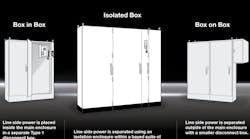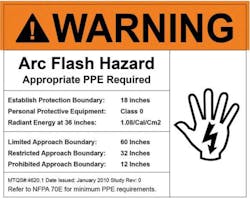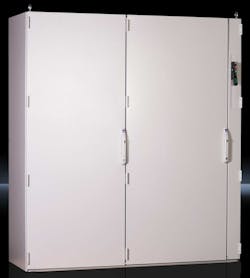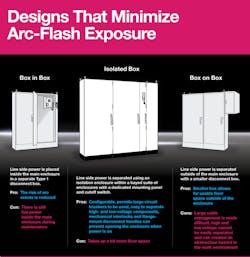Arc flashes present a serious hazard involving electrical equipment that is more common than many would believe. Due to OSHA’s reporting requirements for arc flashes, they are underreported or not reported at all. No one is certain how frequently they occur, but some sources estimate there are five to 10 electrical equipment explosions (aka arc flashes) each day in the U.S.
Most reports on electrical-related injuries focus on shock and electrocution, rather than arc flashes in which explosive forces, heat, and gasses cause the injuries and deaths, according to the National Fire Prevention Assoc. But research conducted across burn centers show arc flashes cause 34% to 55% of all the electrical burns received on the job.
It has been estimated that more than 2,000 workers are admitted to burn centers annually to be treated for severe arc-flash burns, and arc flash incidents kill one to two people every day. In addition to injuries and fatalities, arc flash also carries significant financial costs. Medical treatment for arc-flash injuries costs an average of $1.5 million per incident, which is borne by the factory owner. This makes arc-flash prevention and risk reduction a high priority when designing electrified equipment.
Labels indicate boundaries around electric enclosures and levels of personal protective equipment for working inside it.
Arc Flashes vs. Arc Faults
An arc flash is the explosion caused by a phase-to-phase or phase-to-ground short circuit. Arc flashes emit extreme heat, intense light, and violent pressure blasts. In comparison, an arc fault is the high-power discharge that causes the short and triggers an arc flash. Arc faults can be caused by several different conditions, including a faulty wire, a loose fuse, a tool dropped into a live cabinet, or even personal contact with live components.
Arc flashes pose a significant risk for bodily harm from the force of the explosion, heat of the blast, and the corrosiveness of the gasses. Physically, the pressure of the explosion can be as much as 10,000 psi, which compares to the force of a high-speed collision.
In addition to its explosive force, arc flashes carry high temperatures and can reach up to 35,000°F, which is hotter than the surface of the sun. Arc events also create noxious and corrosive gasses that, if inhaled, increase the chances of catastrophic injury or death.
Arc-Flash Regulations and Standards
The Occupation Safety & Health Administration (OSHA) is the governing body that regulates workplace safety, including arc flash prevention, equipment labeling, and use of personal protection equipment (PPE). Specific standards related to arc flash include OSHA 1910.137 for electrical protective equipment and OSHA 1910.269 App E on protection from flames and electric arcs.
The National Fire Prevention Assoc.’s standard NFPA 70E covers safety-related work practices, maintenance requirements, and special equipment requirements. Companies that comply with NFPA 70E must conduct an Arc Flash Hazard Analysis, sometimes called an Arc Flash Study or Arc Flash Analysis. The review determines safe work practices, arc-flash boundaries, and appropriate levels of PPE to be used.
Underwriters Laboratory also has a standard specifically for industrial control panels and switchgear (manufactured and modified). It covers control panels intended for general industrial use and operating at 600 V or less. Equipment meeting this standard is installed in “ordinary” locations in accordance with the National Electrical Code, ANSI/NFPA 70.
As the governing body for workplace safety, OSHA regs are the driving force for compliance in the U.S. Manufacturers that do not meet the regs can be fined by OSHA and lose their insurance. With OSHA issuing fines and penalties when workers are put at risk for arc flash injuries, a common misconception arose that the agency enforces NFPA 70E. Although companies are not specifically required to comply with NFPA 70E, it acts as an outline on how to ensure compliance with OSHA’s arc flash safety regs.
Rittal’s recommendation for minimizing the risk of arc flashes is to use an isolated box design such as its TS 8 Modular Enclosures and comply with relevant codes and standards.
A Closer Look at NFPA 70E
NFPA 70E sets arc flash boundaries for organizations, including keeping 3 ft away from cabinets with electrical circuits running at less than 750 V and keeping 19 feet away from cabinets holding circuits running at 15,000 to 36,000 V. Boundaries are delineated by tape or a chain and show the safe distance from cabinets for workers without PPE.
Arc flash boundaries vary with the risk level and the voltage of the equipment. For instance, a “limited” range is for minimal shock hazards from electrical overarcs; a “restricted” range is for increased shock risks; and a “prohibited” range entails significant risks of direct contact with electrified components. Ranges for these boundaries are outlined in NFPA 70E table 2-1.3.4. and OSHA 29 CFR,1910.269 table R6.
Energized panels or boards must be marked with a danger or warning label that indicates the potential hazard and the level of PPE required (from 0 to 4). Category 0 PPE requires cotton, untreated fiber shirts and pants, safety glasses, and hearing protection. It warns against wearing polyester or synthetic fabrics near the equipment that could melt This category is for areas with the lowest potential for an arc flash event, but the standard warns against wearing polyester or synthetic fabrics that could melt near the equipment. At the other end of the spectrum, Category 4 protection includes an arc-rated suit, along with protection for face and head, hands, eyes, and hearing, as well as a hard hat and appropriate footwear.
(For free access to NFPE 70E, click here.)
Reducing the Risks
To minimize the possibility risk of an arc flash, follow OSHA’s lockout/tagout procedures. When followed closely, they protect workers from hazardous energy release and from the unexpected energization or startup of machinery and equipment.
Lockout/tagout requires that machinery be turned off and disconnected from its energy source before anyone performs maintenance on it. It mandates that authorized individuals either lock or tag the energy isolating device(s) to prevent the release of hazardous energy. An authorized person must also take the required steps to verify energy has been isolated effectively. Lockout devices hold energy-isolation equipment in a safe or off position. They prevent equipment from being energized and can only be unlocked with a key. Tagout devices feature prominent warnings that are fastened to energy-isolating equipment to warn workers not to reenergize the equipment while it is being serviced. Details for using tagout devices are listed in the OSHA standard, The Control of Hazardous Energy (Lockout/Tagout), Title 29 Code of Federal Regulations Part 1910.147.
The safest way to work on any panel is when the panel is turned off. If lockout/tagout is done correctly, maintenance staff can safely work on electric panels without risking exposure to arc flash.
An arc flash assessment, another required safety measure, determines both the potential and intensity of an arc flash. Calculations done in these assessments (found in IEEE 1584, Guide for Performing Arc-Flash Hazard Calculations) helps in creating appropriate training and procedures for anyone working with energized electrical parts, switches, breakers, or other equipment.
The best way to reduce the risk of an arc event with design is to isolate the main line side power. There are several ways to accomplish this, each has its own pros and cons.
Design Measures
Lockout/tagout and arc flash assessments are general safety measures on an operational level. There are also strategies to minimize risk of arc flash exposure at the design level.
The primary design strategy is to isolate the main-line-side power. The concept is as simple as a light switch in your home. If you turn the switch off, you know no power is going to the bulb in the fixture. You can change the bulb or fixture and be reasonably confident you won’t get shocked. However, if you take that same switch in the “off” position and remove the switch cover, there is power on the other side of the switch. It’s the same with panel enclosures; even with a switch turned off, there is still live voltage on the other side of it, and therefore, significant risk for arc flash.
There are three ways to design electrical equipment that isolates the main power: box-on-box, box-in-box, and isolated box. There are benefits and drawbacks to each of these, but any of them can isolate the main by incorporating a separate enclosure as a disconnect box.
Box-on-box design. This method puts line-side power outside of the main enclosure by mounting a smaller disconnect box with a cutoff switch outside of it. The smaller enclosures either does not allow for or makes large cable management extremely difficult for higher-amp mains. Interlocks are used as a way to prevent access to the inside of an enclosure when power is not disconnected. However, the proper UL508A interlocks are challenging to install in this type of design. This design can also make it difficult to separate low and high voltage. And the small enclosure can eat up usable floor space and create an obstruction hazard.
Box-in-box design. In this method, line side power is inside of main enclosure running through a separate disconnect box. When the switch in the disconnect box is off, the rest of the main enclosure is separated from the power at the panel. Although the risk for an arc events is reduced, there is still live power inside the main enclosure during maintenance.
Isolated box design. This method, the one preferred by Rittal engineers and managers, is sometimes called a power isolation enclosure. It separates line-side power inside of a connected set of modular enclosures (known as a bayed suite of enclosures) in a larger isolation enclosure with a dedicated mounting panel and cutoff switch. Disconnect boxes, such as those used in the other two methods, are limited in size options due to their placement. However, standard, off-the-shelf, modular enclosures like those in Rittal’s isolated box designs can be anywhere from 400 to 1,800 mm wide to fit the needs of the application, the available footprint, and the size of the equipment inside. This means the isolated-box design is scalable and permits easy separation for high- and low-voltage components.
When the isolated-box design includes mechanical interlocks and a flange-mounted disconnect handle, it can prevent the enclosure suite from being opened when the switch is on. Rittal’s TS 8 modular setup for the isolated box design complies with UL 508A and all workplace safety and electrical codes.
Enclosure Accessories for Arc-Flash Safety
Other ways to reduce the risk of arc flash through design include external control panels and windows that let technicians see inside of an enclosure without opening it. Access connectors, data ports, external data, and print pockets allow access to data generated or contained inside the enclosure without having to open it, while external fold-down shelves offer a convenient place to put computers, tablets, and even tools when accessing data or working just outside the enclosure. These accessories reduce the number of times workers would need to open an enclosure holding electrified equipment. When common accessories are designed into enclosures, or added in retrofit, they can help protect workers and equipment while also reducing the need for shutdowns.
To minimize arc flash risks, it is critical to understand that NFPA 70E standards make it easier to comply with OSHA regulations. NFPA 70E outlines proper training and procedures and PPE standards for manufacturers and their maintenance staff. In addition, engineers can design arc-flash prevention into enclosures so that they serve as the first line of defense. Using the isolated box approach, customized with appropriate accessories, manufacturers can prevent unsafe access inside enclosures. As manufacturers look to improve efficiency and safety of their operations, developing and executing proper arc flash prevention standards will ensure the health of their staff and their bottom line.
Robbie Hall is a systems consultant with Rittal North America. If you have any questions regarding enclosures, contact Rittal at (800) 477-4000 or click here.




